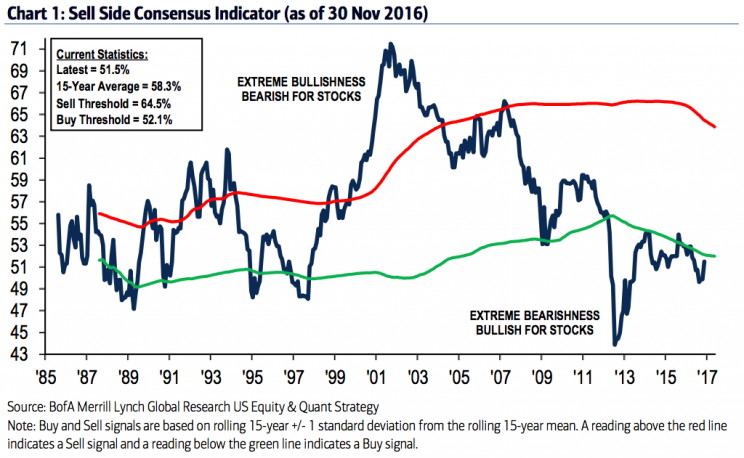This contrarian indicator says the S&P 500 is set to surge 19%
Is the S&P 500 about to rise 19%?
Depends who you ask.
But according to Bank of America Merrill Lynch’s sell side consensus indicator, the market’s current positioning indicates we could see a major rally in the stock market over the next year.
BAML’s sell side consensus indicator tracks recommended stock allocations inside portfolios. A traditional benchmark equity allocation is 60%-65% of a portfolio. And so when the consensus recommendation comes in below this level, it is a contrarian indicator pointing to gains ahead for stocks as managers revert to the expected allocation mean.
And so while the firm’s measure of how bullish investors are on stocks jumped to a six-month high in November — the recommended allocation to stocks jumped to 51.5% — this is still at a level which implies stocks are set to rise over the next 12 months.

“Historically, when our indicator has been this low or lower, total returns over the subsequent 12 months have been positive 97% of the time, with median 12-month returns of +25%,” the firm writes.
“With the S&P 500’s indicated dividend yield currently above 2%, that implies a 12- month price return of 17% and a 12-month value of 2576. Although this is not our S&P 500 target, this model is an input into our target, along with fundamental and technical signals.” (Emphasis added.)
Now, as the firm notes, BAML stock strategist Savita Subramanian has a price target of 2,300 on the S&P 500 for 2017, far below the returns implied the consensus indicator.
‘Anything but normal’
In publishing this 2,300 S&P 500 price target, however, Subramanian cautioned that, “2017 could be anything but normal.”
“We see fat tails and a binary set of outcomes,” Subramanian added.
“Against the backdrop of elevated valuations, slow growth and limited scope for credit expansion, our target and the recent rally are reliant on policymakers’ ability to deliver growth next year. Trump’s comments on trade and GOP comments on deficits/spending could drive big market swings in the coming months. Risk-reward will be more important than absolute targets.”

The end of bull markets, Subramanian wrote, are typically ushered in by a euphoria-powered blow-off top. And when one considers the potential for growth-positive policies from the Trump administration to stoke investor sentiment, “The case for a traditional euphoria-driven end-of-bull-market rally is easy to argue for,” Subramanian wrote.
Under this scenario, the S&P 500 could rise to 2,700, even exceeding the huge returns forecast by the sell side model.
On the flip side, a disappointment from Washington and current inflation trends turning into “stagflation” — that is, rising prices and slowing growth — could send the benchmark index down to 1,600.
Again, fat tails in 2017.
‘Great unwind’
The basic logic underpinning the case for higher stocks given BAML’s sell side indictor is not much different from analysis we saw out of Deutsche Bank in November.
Deutsche Bank strategist Andreas Bruckner asked in a note to clients whether Trump’s election would trigger the “great unwind” in markets.
And while the “great unwind” sound ominous, it is really just another way to say a move of money out of bonds and into stocks, a trade strategists have been calling for for years now.
“Expectations of a looser US fiscal policy added fuel to the reflationary fire, triggering a bond sell-off across regions and classes on the one hand while also arranging for a strong return of equity inflows on the other hand,” Bruckner wrote.
—
Myles Udland is a writer at Yahoo Finance. Follow him on Twitter @MylesUdland
Read more from Myles here:
